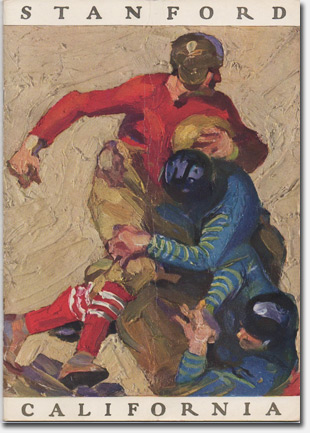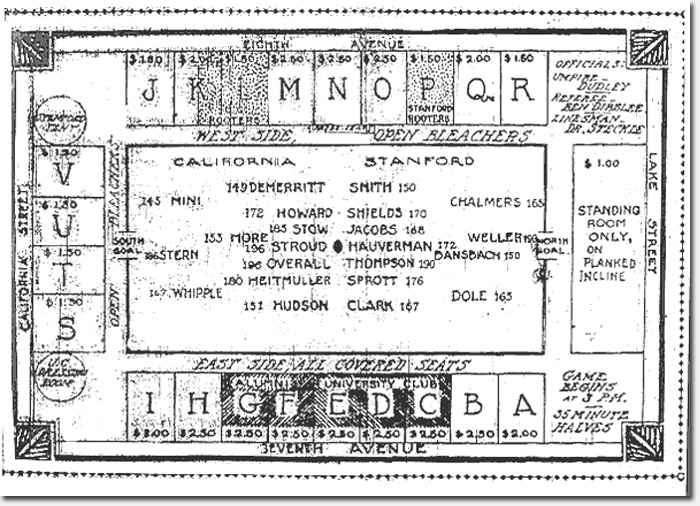Tomorrow is the 116th Big Game between Stanford University and University of California at Berkeley (“Cal”), one of the greatest and longest running rivalries in college football. This year’s game will be at Stanford and every year, the venue alternates between campuses.
But 111 years ago, things were a little different. The Big Game venue had hopped around the Bay Area since the rivalry first started in 1892. Neither school had a field that could accommodate the thousands of students, alumni and football fans that came to watch, so the first thirteen Big Games were played in San Francisco.
 The last two to be played in San Francisco, in 1902 and 1903, took place right here in the Richmond District.
The last two to be played in San Francisco, in 1902 and 1903, took place right here in the Richmond District.
A “SANDY” SITE FOR THE NEW STADIUM
In October 1902, the athletic directors from each school announced they had decided upon a site for that year’s game. It was to be at a site described as “sandy” which is exactly what the neighborhood sits on – tons and tons of sand. Back in 1902, the Richmond District was not richly populated and a lot, bound by Lake Street, 7th Avenue, California Street, and 8th Avenue, was chosen to be the home of the new Richmond Grounds stadium.
Preparations were rushed and carpenters built fences, bleacher seats and grandstand coverings, and horse-drawn wagons brought in load after of clay and loam to put on the sandy surface of the field.
THE EARLY DAYS OF NIMBY-ISM
Things were going swimmingly until Richmond District residents living near the new stadium started to panic, fearing that the new venue would attract the wrong element to their quiet neighborhood. Two weeks before the game, residents went before the Streets Committee of the Board of Supervisors to make their objections known.
After a rowdy hearing, probably much like the recent Beach Chalet hearings, a compromise was reached. The schools would only be allowed to play three additional games at Richmond Grounds, and the stadium would have to be removed by January 1904. With that settled, the 1902 Big Game could proceed.
Three days before the game, the Daily Californian described the new field:
- The new football grounds near the Marine Hospital at San Francisco are the most picturesquely situated that were ever selected for the big Varsity game. They are at Seventh Avenue and California Street, about midway between the Presidio Golf Club house and the Marine Hospital, and are very close to the Maria Kip Orphanage.
There are splendid great grand stands for seating 13,500 people. The whole east side of the field is one great towering gently sloping hillside of substantial benches under cover, and the entire west side of the field will have similar seats without cover for the college rooters.
A story in the Chronicle mentioned the ticket prices – $2.50, $2.00, $1.50, or $1.00 – but said anyone without the means would be able to sit up on the hillside abutting the Presidio Golf Course and get an excellent view. Perhaps a forefather to Cal’s now infamous Tightwad Hill?
Keep in mind this stadium went up quickly and would not have rivaled onhealthy serevent what we’re used to seeing college football played on today.
- The fans would not have seen a grass field, but a mixture of clay, sand and loam. The field sloped slightly downhill toward the north goal. Coupled with the day’s prevailing wind from the south, the team defending the south goal had an offensive and a defensive advantage. [Outsidelands.org]
The 1902 game kicked off at 3pm and ended in a shutout, with Cal defeating Stanford 16-0. The game included a field goal (only the second in Big Game history), and a 90 yard punt return for a touchdown.
Revenue from the game totaled $23,000, covering the land lease and the cost of construction of the facility, and netting each team almost $9,000. Local newspaper The Call later estimated that 2,000 people watched the game from outside the field.

The seating chart for the 1902 Big Game at Richmond Grounds. Courtesy of outsidelands.org
THE FINAL TWO GAMES AT RICHMOND GROUNDS
Though the schools had permission to play three more games in the Richmond Grounds, it would only be used twice more. First for the freshmen teams to square off in October, 1903 where Stanford emerged with a 12-0 victory before 5,000 spectators.
The final use for the Richmond Grounds was for the 1903 Big Game that November. Demand for tickets was high as it was shaping up to be the last time that the game would take place in San Francisco.
Residents anticipated big crowds, and requested more police presence, claiming some tightwads from the year before had damaged their houses and trees while trying to see the game.
Kickoff was at 3pm, but fans began filling the Richmond Grounds as early as 10am. With 15 minutes to go in the game, the score was tied 6-6. Stanford attempted a field goal from Cal’s 36-yard line, but it fell short. Final score: 6-6
Traditionally, the winning team’s supporters rush the field after a Big Game, but the crowd in 1903 didn’t know what to do with a tie. Eventually, BOTH team’s fans rushed the field and each school’s brass bands burst into life.
- Out of their seats, over the rails and onto the field poured a bell-ringing, pennant-waving, horn-blowing, cheering mob. As the shadows lengthened across the Richmond Grounds, two separate bodies of celebrants gathered behind the respective bands. Forming themselves into enormous lines, they serpentined over the field, leaving the final footprints on the field of the Richmond Grounds. [outsidelands.org]
No more games were ever played on the Richmond Grounds and its dismantling began shortly after the 1903 Big Game, since it was due to be removed by January 1904. And so ended the collegiate football history of the Richmond District.
Good luck to both teams tomorrow!
Sarah B.
The content for this post came from a well-researched article entitled The Richmond Grounds and the Big Games of 1902 & 1903 by Angus Macfarlane, who was a Sunset District resident and Cal alum.

Where the Richmond Grounds was built in 1902, bound by Lake Street, 7th Avenue, California Street and 8th Avenue.

Courtesy of “San Francisco’s Richmond District” by Lorri Ungaretti
Great job of summarizing a little-known historic event, Sarah. Credit should be given to Angus Macfarlane, a UC-Berkeley grad and Sunset District resident, who tenaciously researched this lost piece of Big Game and Richmond District history.
@John – Thanks, John. There are many links back to Angus’ original article in the post, but I also added an additional credit at the end.
Sarah
great stuff thanks!
Cool article!! Some time ago I checked “San Francisco’s Richmond District” out of the library. I was surprised to learn that the neighborhood was also a HUGE racetrack!
Very cool! Thank you.
Stanford grad on 5th Ave.
Love the article. The historical Richmond District articles are my favorite.
What an awesome story. Thanks for digging this up!